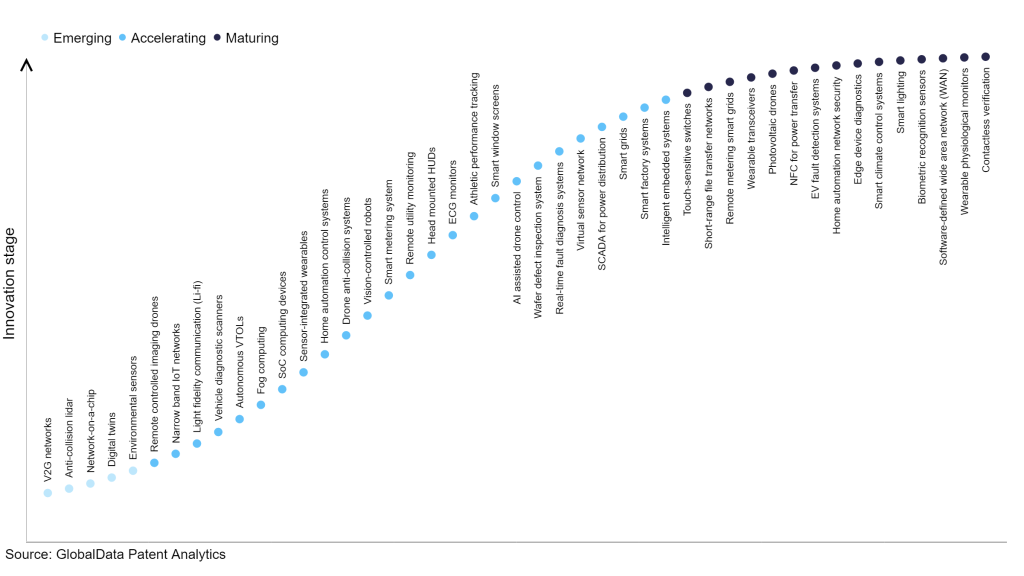The technology industry continues to be a hotbed of innovation, with activity driven by artificial intelligence (AI), Internet of Things (IoT), and robotics, the increasing demand for wireless charging solutions, and growing importance of technologies such as near field communication (NFC) devices, wireless charging coils, power management systems, and data encryption mechanisms to enable secure and efficient wire-less power transfer. In the last three years alone, there have been over 3.6 million patents filed and granted in the technology industry, according to GlobalData’s report on Innovation in Internet of Things: NFC for power transfer. Buy the report here.
However, not all innovations are equal and nor do they follow a constant upward trend. Instead, their evolution takes the form of an S-shaped curve that reflects their typical lifecycle from early emergence to accelerating adoption, before finally stabilising and reaching maturity.
Identifying where a particular innovation is on this journey, especially those that are in the emerging and accelerating stages, is essential for understanding their current level of adoption and the likely future trajectory and impact they will have.
300+ innovations will shape the technology industry
According to GlobalData’s Technology Foresights, which plots the S-curve for the technology industry using innovation intensity models built on over 2.5 million patents, there are 300+ innovation areas that will shape the future of the industry.
Within the emerging innovation stage, environmental sensors, digital twins, and network-on-a-chip are disruptive technologies that are in the early stages of application and should be tracked closely. Intelligent embedded systems, smart factory systems and smart grids are some of the accelerating innovation areas, where adoption has been steadily increasing. Among maturing innovation areas are, contactless verification, wearable physiological monitors, and software-defined wide area network, which are now well established in the industry.
Innovation S-curve for IoT in the technology industry

NFC for power transfer is a key innovation area in IoT
Near field communication (NFC) is a wireless communication technology that facilitates the exchange of data between two compatible devices in close proximity, typically within a few centimetres. In addition to data transfer, NFC can also be utilised for wireless power transfer, enabling devices to exchange and share electricity without the need for physical connections or cables.
GlobalData’s analysis also uncovers the companies at the forefront of each innovation area and assesses the potential reach and impact of their patenting activity across different applications and geographies. According to GlobalData, there are 80+ companies, spanning technology vendors, established technology companies, and up-and-coming start-ups engaged in the development and application of NFC for power transfer.
Key players in NFC for power transfer – a disruptive innovation in the technology industry
‘Application diversity’ measures the number of different applications identified for each relevant patent and broadly splits companies into either ‘niche’ or ‘diversified’ innovators.
‘Geographic reach’ refers to the number of different countries each relevant patent is registered in and reflects the breadth of geographic application intended, ranging from ‘global’ to ‘local’.
Patent volumes related to NFC for power transfer
Source: GlobalData Patent Analytics
Intel is one of the leading patent filers in NFC for power transfer. The company’s patents are aimed at a third-generation partnership project (3GPP) monitoring architecture framework providing monitoring event configuration, detection, and reporting for machine-type and other mobile data applications.
The framework uses a machine type-communication interworking function (MTC-IWF) that communicates monitoring event configuration, detection, and reporting messages through existing interfaces, such as Tsp, T4, and T5 interfaces.
Other prominent patent filers in the space include Sony Group and Apple.
By geographic reach, Johnson & Johnson leads the pack, followed by Otsuka and Amer Sports. In terms of application diversity, Johnson & Johnson holds the top position, followed by Apple and Dekodur.
IoT innovations in near-field communication for power transfer have introduced a new paradigm for wireless charging and energy transfer. NFC technology, commonly used for contactless data exchange, is now leveraged to enable power transfer between devices. The innovation enables efficient and convenient charging of IoT devices, eliminating the need for physical connectors or cables.
To further understand how IoT is disrupting the technology industry, access GlobalData’s latest thematic research report on Internet of Things – Thematic Research.
Data Insights
From

The gold standard of business intelligence.
Blending expert knowledge with cutting-edge technology, GlobalData’s unrivalled proprietary data will enable you to decode what’s happening in your market. You can make better informed decisions and gain a future-proof advantage over your competitors.







